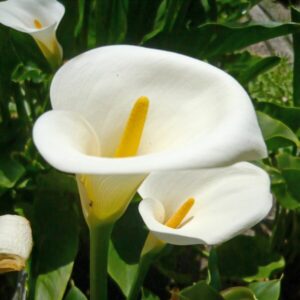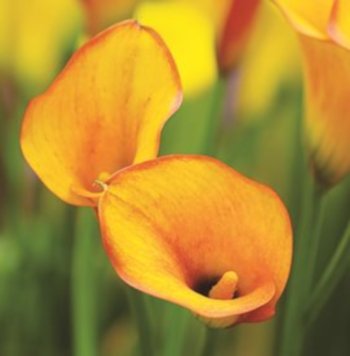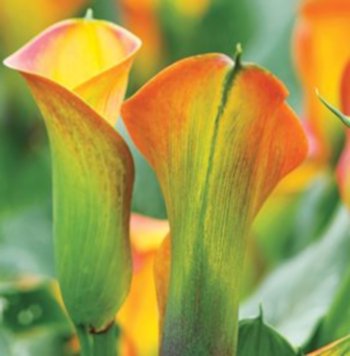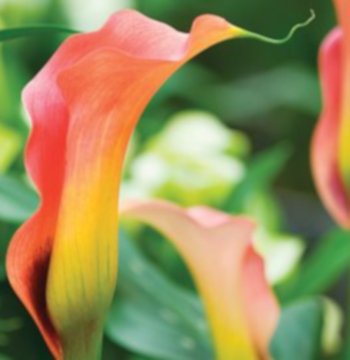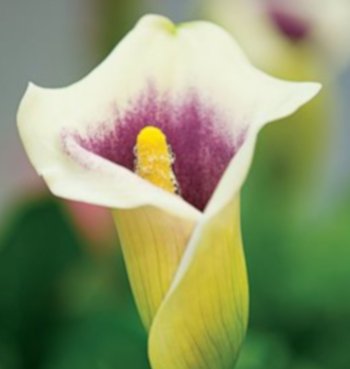[vc_row][vc_column width=”2/3″][vc_column_text]
Calla Lily Flower, as many other special wedding flowers, is an exotic flower, very sensual, graceful and suggestive. These flowers grow very easily in the garden and caring for them can be very easy.
There are many variations in flowers available in this world but there are only a few flowers who make an impressive impression and those are the Calla Lily Flowers.
In our earlier days, people use to hesitate for showing care or conveying feelings and rather felt awkward in talking the same; since those days flowers have made things easier in conveying the message.
Click here to see the table of contents
Calla Lily Flower Meaning
Each flower has a different meaning to it; Calla Lily was famous amongst them and popular because it was used to express love/lust a desire for somebody special. With time, Calla Lily became the significance of purity and faith, it was observed that Calla Lily was majorly used for wedding purpose but nowadays it has become a part of every celebration/occasion.
They have some special feeling attached because of the occasion they are being used. Calla Lilies are in great demand mainly in wedding celebrations. With Calla Lily, the celebration looks so beautiful and charming. Calla Lily is known as a flower of celebration.
The calla lily is exceedingly popular at weddings, and for good reasons. The flower is not only gorgeous to look at; it is also a symbol of true and magnificent beauty according to the old flower language. The flower language experienced a boom during the 19th-century Victorian period.
During this era, the social codes prompted strict control, and telling the object of the affection of your true feelings could not be done openly. The flower language, therefore, became a way for loving couples to send each other passionate messages, while still conforming to the strict social etiquette. During this period, the stylish calla lily became a symbol for several related terms.
According to “Hill’s Manual of Social and Business Forms” that was published in Chicago in 1883, the calla lily meaning can be either modesty or delicacy depending on the context. A well-composed floral bouquet containing calla lilies as well as other flowers could convey a much more intricate message than what was possible using a single solitary flower.
Another book published by John H. Young that same year – “Our Deportment, or the Manners, Conduct, and Dress of the Most Refined Society; including Forms for Letters, Invitations, Etc., Etc. Also, Valuable Suggestions on Home Culture and Training. Compiled from the Latest Reliable Authorities” – claimed that the true calla lily meaning was beauty, more specifically feminine beauty. According to “Kate Greenaway’s Language of Flowers” from 1885, the calla lily meaning is magnificent beauty.
Always be careful when you combine your floral bouquet since the calla lily meaning can be altered by the flowers with which it is combined. You can also use different colored calla lilies to change the calla lily meaning.
Calla Lily Flower Care
Caring for the Calla Lilies may be different than caring for the more colorful sisters, the hybrid calla lilies. For example, White Calla Lilies are semi-quality, and their rhizomes thirst for watering holes.
The other advantages of the White Calla Lilies are:
- Blossom just 8 weeks after it was planted.
- Have a very beautiful arrow-shaped foliage.
- It offers a generous beautiful color range.
Calla Lily Zantedeschia Aethiopica
Calla Lily Zantedeschia Aethiopica has a long history in the United States as the classical tall, white chalice-shaped cut flower. Its most traditional use is for weddings. It has recently gained additional popularity as a potted plant, due in part to the registration and use of the growth retardant Bonzi, and fuller, more compact cultivars.
Aethiopica is more temperamental in regards to exact potted flower scheduling compared to colored Callas. However, as a potted plant, Aethiopica is a robust grower that withstands variations in light and temperature and frequently can be grown outdoors, or under partial (or full) cover in temperate climates. Cooler temperatures below 70°F (21°C) maximum, preferably in the 60’s or 50’s on average, will help reduce disease incidence and severity. At these optimal regimes, you will see increased flowers due to superior growth and lack of stress.
1. Availability and handling
Calla Aethiopica rhizomes are available in the northern hemisphere from the month of August to November. Upon arrival, unpack rhizomes and put in well-ventilated trays until potting up. Care must be taken in holding rhizomes too long or desiccation and weakening may occur.
2. Scheduling
For a potted crop or covered fall planting, allow approximately 11 to 14 weeks for initial bloom flushing. Some first flowers may come as early as 8 to 10 weeks, especially for later plantings of more sprouted rhizomes. Although sprouted and larger bulbs are sometimes earlier, bulb size alone does not consistently affect time to flower.
Unlike spring colored Callas, Aethiopica does not respond with an initial gibberellic acid (GA) induced flower flush and application would have little use on a potted crop. However, there is some evidence that a delayed GA response occurs six to ten months post-application and may benefit late spring cut-flower production. Rates from 80-250 ppm may be trialed, with higher rates possibly increasing flower deformity and height. GA affects cultivars Green Goddess, Pink Mist and Childsiana more strongly compared with the standard White Aethiopica. in these varieties and for cut flower plantings, use GA as a foliar spray at above rates.
3. Horn vs. cluster rhizomes
Aethiopica come as elongated and naked (without multiple side bulblets attached) rhizomes called ‘horns,’ or as broader, more compressed rhizomes with some attached bulblets called ‘clusters,’ or somewhere in-between.
Horns tend to grow with a more dominant apical shoot, have fewer side shoots (which produce lower canopy leaves), and have generally larger, taller and heavier stemmed flowers.
Clusters tend to have more or multiple breaks or budding around the main apical shoot, fuller, more compact plant habit, and lower bloom heights in relation to the leaf canopy.
Although interchangeable to a certain degree, clusters are favored somewhat for potted production and horns for cut flowers depending on your flower and/or plant habit objectives. Flower counts on average are similar for equal sizes.
4. Potting, planting and watering
Rhizomes can be planted in either raised beds or containers and prefer a deep, well-draining soil. Plant bulbs 2″ deep in containers and 3-4″ deep in the open bed. Pot or plant in a well-draining media with a pH of 5.5-6.5 and high in organic matter. Successful media generally have 50-65% peat with other components being coarse for drainage. Lime, gypsum and dolomite as calcium sources in the media are recommended for plant health. Incorporation of Terraclor (PCNB) and/or Trichoderma into media helps reduce disease.
Water freshly planted rhizomes, then fungicide drench immediately. Maintain slightly moist until substantial sprouts emerge. Keep constantly moist, but not soggy, until peak bloom, then decrease moderately.
Because of the robust nature of the Aethopica potted plant, larger pots or tubs of 10-12″ or medium pots of 6-8″ are generally used, although some experimentation has been done with smaller, more growth-regulated pots. Greater flowering and growth comes with greater root space. Cluster type bulbs or multiple (2-3), smaller diameter horns 1 1/4″ to 1 3/4″ will help fill out potted plantings and maximize bloom per pot. Larger horns simply will not fit in the medium or smaller sized pots.
5. Fertilization
Fertility maintenance is critical to continued flower production and full, well-colored plant growth in Aethiopica. We recommend that a pre-plant charge of nitrogen and potassium, with little or no phosphorus, be incorporated into the media. This will produce good, early establishment of roots and improved, early vigor. Use only a 30-day release formula then begin a balanced liquid feed at 200 ppm weekly or 100 ppm constant or as needed. Modifications can then be based on individual growth objectives and environments.
6. Temperature and environment
Night temperatures of 45-55°F and day temperatures of 55-65°F are optimum for plant growth and flowering and must be followed or greater disease problems can occur, especially in warmer conditions. Therefore, the best outdoor growth generally occurs in the spring and fall. Prolonged warmer greenhouse temperatures, especially at night, can inhibit flower production and can soften and stretch existing blooms. Moderate early warming to 65-70°F, only until sprouting, however, can help hasten rooting and establishment. Avoiding high-temperature spikes will help minimize root problems.
Calla Aethiopica withstands a wide range of light conditions from 500 to 5,00 foot-candles. It is not day-length sensitive nor does it require temperature treatments to induce bloom. 50% shade is optimal, although the plants can handle full sun to 70% shade without becoming too badly stressed. Stem length is increased, but weakened, under shaded conditions.
Callas are somewhat frost-sensitive and foliage will not withstand prolonged freezing temperatures. Rhizomes will take some frost but cannot withstand a soil freeze to bulb depth. High daytime temperatures, such as in hoop houses, are conducive to the proliferation of fungal and bacterial diseases. Cool nights and days will promote stronger and shorter stems.
7. Fungicides and pesticides
Aethiopica, particularly if potted or in beds, benefit greatly from an aggressive preventative fungicide program. Incorporation of PCNB (Terrachlor) into media at 3-5.5 oz/yd3, and Trichoderma (Root Shield) at 1 lb/yd3 will help to maintain healthy roots. The two products are compatible. Either product used alone will also yield benefits. Immediately after initial watering of media, follow with a thorough fungicide drench of Subdue (1-2 oz/100gal) for water molds, combined with either the newly available Medallion (1-2oz/gal), Compass or Heritage (0.4 oz/gal).
If these new (and improved) fungicides are not available in your area, use Cleary’s 3336 or FungoFlo at recommended rates for Rhizoctonia, along with the Subdue. PCNB is most effective as an incorporate but can be drenched with the above products if not added to the media. Including Agrimycin in the drench at 100-200 ppm (0.5-1 lb/100 gal) will also help suppress Erwinia soft rot, a bacterial disease that often becomes established in the damaged root tissues caused by the more aggressive fungal pathogens. Alteration or addition of Aliette at 13 oz/00 gal) can help manage watermolds.
Always examine roots weekly, or more often for symptoms of clearing or browning or other disorders. A second drench is recommended at 14-30 days including PCNB and/or Trichoderma to maintain long-term pot health. Avoid prolonged and overly soggy or overly dried soil conditions. Separate any diseased or rotted pots. Avoid temperature and humidity extremes in greenhouses below 40°F or above 70°F for the best health.
A preventative foliar disease program is best. Use copper Kocide or Champion sprays at 1 lb and at 1 qt per 50 gal respectively. These can be rotated with Daconil (do not mix Daconil with copper). This foliar treatment is especially recommended for pathogen-conducive environments such as outdoor plantings and in cut flower blocks. We also encourage, on a trial basis, the use of new chemicals or mix combinations, and good record-keeping for future reference. Aethiopica tend to be tolerant of most pesticides.
8. Insects
To control aphids, thrips, shore flies and fungus gnats (shore flies and fungus gnats can spread bacteria), Orthene, Diazinon, Malathion, Tempo, Dursban and Maverik have shown effective and non-phytotoxic. Control is also very effective on fungus gnat larvae. Check registrations in your area.
9. Bonzi
In Aethiopica, Bonzi (Paclobutrazol) growth regulator use can improve the potted plant growth habit dramatically. Trials on rates, timing, multiple applications, bulb size and configuration, soil media, and environmental differences are absolutely essential. Aethiopica is sensitive to Bonzi and too high a rate or too early an application can cause leaf crinkling, plant rosetting, lack of bloom or disproportionate (disparity in) flower-foliage height.
A rule of thumb for a single dose is to make and application when plants are at 1/2 to 3/4 desired plant height. Again, the rate will depend primarily on the light and temperature effects on stretching and your bulb size and type. The best range to start trials is 1/4 – 1/3 oz Bonzi per gal (7-10 ppm) and going down to a 1/8 – 1/4 oz for lighter effects, earlier or multiple applications or use of smaller or clustered bulbs. Rates higher than 10 ppm may arrest plant height completely and may be evaluated under more extreme stretching conditions or if the final desired has been attained.
Use of Bonzi is truly an art as well as a science and these recommendations have been tested on the central coast of California. Drenching is best done one to two days after watering to insure uniform soil moisture. It should be noted certain organic media components such as composted or uncomposted pine bark, widely used in the eastern USA, have shown up to 10 times reduced efficacy of Bonzi. Temperature, nitrogen fertility, light and water management, morning cold pulsing, or far-red light (twilight) exclusion manipulations can separately or together affect growth habit and thus Bonzi applications.
Bonzi in Aethiopica, as in spring colored Callas, reduces foliage height, darkens leaves and toughens or tones plants, which can improve shipping and post-harvest life. However, it can also reduce foliage height, and perhaps reduce later flower numbers at the higher rates. Use care and experiment, always using untreated controls.
10. Harvesting flowers
Cut flowers at earliest when yellow spadix (the little finger-like thing in the middle of the bloom) is just visible at 10-15% open spike stage. Tighter spikes will not open naturally. Aethiopica can be cut at late stages to fully open, but may not ship as well due to packing and bruising. Flowers should always be cut before pollen shed.
Flowers can be picked either by pulling stems or by cutting stems. There are advantages and disadvantages to both techniques. Pulling stems increases stem length and is a much quicker technique. However, some research shows that younger flower primordia may be damaged this way and stem “stretching” or bruising can take place if picking is not done correctly. We recommend pulling stems, but the soil must have proper moisture or stem “stretching” will occur.
Cutting stems reduces the chance of flower primordia damage as well as stem stretching, but the resulting stem length is slightly shorter. Some diseases caused by viruses or bacteria may be transmitted, so knife disinfection should be practiced.
It is up to each individual grower to decide which method is best for their operation.
Flowers should last up to three weeks or longer when cared for properly.
11. Post-harvest handling
Flowers should be placed in clean water immediately after picking in the field then re-cut and bunched according to stem length and quality. They should be kept in a commercial flower keeping solution such as Floralife or in a solution of sugar and bactericide (Clorox). Too high a concentration of sugar in the solution will encourage premature flower opening and increase microbial growth in the solution. Stem splitting, in our experience, is worse in pure or less hard water.
Flowers should be stored at 36-40°F and no lower than 34°F. Stems should be re-cut and solutions changed every two days, if not daily. Bucket and work surface sanitation is very important to vase life and flower quality. When bunching flowers, take care not to bunch stems too tightly thereby restricting solution uptake.
Calla Lily Flower – Cultural Information
Introduction
Calla Lily Bulbs are indeed a high-value crop, and with this high value comes increased risk of disease during the calla lily production cycle. Stress management is the key to the successful production of colored calla lilies. By minimizing stress to the calla lily plant, the plant’s susceptibility to disease is also minimized and a profitable crop prevails.
Calla lily soft rot, caused by the Erwinia carotovora bacterium, is the main limiting factor in calla production. Once a calla lily tuber is infected, there are no chemical or other control methods that will rid the tuber of this bacterium. Infection from this disease is a secondary infection, however, primary infection usually occurs via Pythium, Rhizoctonia, Phytophthora, or fusarium. These fungal pathogens stress or damage the calla lily bulb and allow the invasion of soft rot. Therefore, all management practices should aim at preventing primary infections from fungal pathogens and to culture a strong, healthy calla lily plant.
Detailed management of air and soil temperature, media selection, water availability, plant nutrition, and a preventative disease program is essential to the culture of calla lily bulbs.
Temperature
Temperature is vital to the performance of calla lily tubers. The ideal day/night temperature regime is 65°-75°F/55°-65°F. Recommended soil and media temperature is 65°F. It is important to keep soil temperature below 75°F because higher temperatures cause stress and contribute to disease. Shade cloth, greenhouse paint, or soil mulches can all help to control heat stress and to improve flower quality.
Soil Media
Calla lilies grow best in loose, free-draining soils with a pH of 6-6.5. This applies to both natural soil and soilless growing media. Crop rotations or periods of fallow are important to prevent the buildup of Erwinia. If drainage is a problem, plant in raised beds.
Irrigation
Calla lilies require an ample supply of water. Until leaves unfurl, the water uptake is not real large, but the tuber requires moisture to grow and should be kept damp. At the vegetative leaf growth phase, the plant grows quickly and water uptake increases greatly. Even, consistent watering is important as Callas are easily stressed by too little or too much water. Drip and overhead irrigation can be used. At the end of the growing cycle when plant senescence begins, water should be withheld.
Nutrition
In a soilless growing media, a balanced three to four-month slow-release fertilizer plus minors can be incorporated or top-dressed. The addition of calcium in the media may help with disease control and is a good precaution. Weekly fertigation also works well, beginning at leaf emergence and extending until first bloom with approximately 200 ppm N using 20-10-20.
The addition of calcium in natural soils is thought to help subdue the severity of soft rot as well. Upon the results of a soil test, the addition of NPKMg plus trace elements is used to supply the necessary nutrients for plant growth. Organic matter helps the nutrient and water holding capacity of soils, and is greatly beneficial to tuber growth. Excessive use of N will result in weak stems and leaf growth, as well as increased susceptibility to soft rot.
Planting
Infield production, one-meter wide beds are generally used. Planting densities for 3cm, 4cm, and 6+cm tubers are 35, 25, and 15 tubers/meters2 respectively. Ensure that tubers are planted upright and covered with 2 in. of soil. Larger tubers (2 in.+) should be planted 3-4 in. deep to keep tubers out of hot soil during the heat of the summer.
Pre-Plant Sprays/Dips
All flowering stock should be dipped or sprayed with Gibberellic acid (GA3) or Promalin (GA4+7) prior to planting. Permalink is the preferred compound as less deformed flowers will be produced. The use of gibberellic acid can increase flower initiation by up to 300%. For spraying, use 100 ppm Promalin or 125 ppm GA3. For dipping reduce Promalin to 75 ppm or GA3 to 100 ppm. It is also beneficial prior to plant to dip or spray with a suitable fungicide and bactericide solution (e.g. Kocide, Champ II flowable).
Weed Control
Calla plants are tolerant of a range of herbicides in the aid of weed control. A pre-plant eradication of perennial weeds with Roundup and a pre-emergent application of Simazine or Surflan is suggested. Weed control can be extended with an additional post-emergent application of Simazine or Surflan. Weed control in the latter half of a calla’s production season is not a problem as the dense foliage helps to reduce weed growth.
Insects
Thrips and aphids are the main pests of Callas. Control is important to prevent the spread of viruses and fungi. A preventative spray program is recommended as flower spikes emerge, to be repeated at 7-10 day intervals during flower production. Insect control via chemical application may be necessary following flowering as well due to increased disease pressure and its concurrent spread with the presence of thrips and aphids.
Fungal Pathogens
As previously mentioned, calla lily tubers can be attacked by a range of fungal pathogens including Pythium, Rhizoctonia, Phytophthora, or fusarium, acting as a precursor towards soft rot syndrome. These all attack the root zone and common symptoms include withering, yellow, rolled up leaves, and subsequent collapse of the base of the stem. A broad-spectrum drench every 2-4 weeks from planting onwards is crucial to controlling these fungi. In pot production, the use of 1) Agrimycin-17 @ 100-200 ppm; 2) Aliette @ 13 oz/100 U.S. gal.; 3) Chipco 26019 @ 6.5 oz/100 U.S. gal. is the preferred combination of fungicides. In natural soils, Benlate, Thiram, and Aliette is a good combination for broad-spectrum control.
Fungal spotting on flowerheads during humid and/or rainy weather is a common problem. Protectant fungicidal sprays should be used every 7-10 days during problem periods. Be careful of residues on flowers.
Flower Harvest
Harvest flowers in the cool of the morning or evening. To ensure the longest possible stem length, flowers are pulled rather than cut. Coolstore flowers at 45-48°F for 8-12 hours in a solution of flower preserve. This will minimize stem splitting and rotting, and control post-harvest fungal diseases. Re-cut the stems before they are placed in the condition solution. Pre-treated flowers can be transported dry for up to 3 days.
Tuber Lifting
After plant senescence begins (visible with the onset of yellow and decaying leaves), lifting of the tubers can occur via hand digging or modified diggers. Great care should be taken during lifting, as young tubers are easily bruised or injured, allowing diseases to enter. It is also important not to harvest the tubers prior to the beginning of plant senescence. During plant senescence, tuberization (the replication of new tubers) is completed and the surface of the tuber becomes tougher.
Curing
Wash tubers gently to remove soil. Then dip tubers in an appropriate fungicide solution (e.g. Kocide) for 5-10 minutes. This helps to eliminate fungal pathogens. Dry tubers within 4-6 hours with air-assisted fans if need be. Subsequently cure bulbs for 3-7 days at 70-80°F, ensuring good air movement. This curing stage is important in forming an outer skin on the tuber, which acts as a barrier to dehydration and disease. Store tubers in a single layer on mesh trays at 45-50°F for a minimum of two months prior to subsequent plantings.
There are many types of Calla Lilies:
Calla Lily Flower “Treasure”
Known as one of the most beautiful wedding flowers of all time, when Calla Lily Treasure is fully open, it is fair to say that it deserves the nickname “The Magnificent Beauty”, which was the meaning of it in the “Victorian Language of Flowers”.
Calla Lily Flower “Captain Safari”
This beautiful flower provides a stunning bi-color beauty with a bright nuance of orange which is perfect blending with golden-yellow, atop elegant, mid-green, arrow-shaped. Your wedding bouquet will be just “Wow!”.
Calla Lily Flower “Mozart”
Like Mozart himself, Calla Lily Mozart can add gratitude and elegance to your Wedding Bouquet. Since the Art and also Beauty represents an individual perception, it’s reasonable to say that each Calla Lily has its charm. It has a lovely peach color which blends with a sublime nuance of salmon-pink.
Calla Lily Flower “Picasso”
Calla Lily Picasso is the artist of any Wedding bouquet. The rosy purple color combined with a beautiful cream-yellow will make your Wedding Bouquet looks like a superstar.
Mini Calla Lilies
Mini calla lilies can be obtained in a wide range of different colors and are suitable for most occasions. Even if you order mini calla lilies, you can get them with extra tall stems. The stems will be thinner compared to those found on large calla lilies and more delicate. Mini calla lilies can be used just like large calla lilies, and will, for instance, look great in large floral arrangements, centerpieces, vases, hand-held, and arm-carried bouquets, corsages, and boutonnières.
Pastel-colored mini calla lilies – such as pallid pink, soft lavender, and pale yellow mini calla lilies – are usually more sought after during spring and early summer, while the deeper and more saturated colors – including the burgundy, black, midnight blue and orange mini calla lilies – experience their peak during fall and winter.
Festive red mini calla lilies can sometimes be hard to obtain in December since these mini calla lilies have become exceedingly popular as contemporary winter holiday decorations. Mini calla lilies can naturally also be obtained in various white shades, including snow white, cream, and egg-shell.
The care requirements for mini calla lilies do not differ from how you should care for larger calla lilies. When you have brought your mini calla lilies home, you should place them in water as soon as possible. Immediately unpack the flowers, and be careful not to harm them.
If mini calla lilies are left without water for more than 15-20 minutes, the stem ends will seal and their water-absorbing capacity will be greatly reduced. We, therefore, recommended you to recut the stems of your mini calla lilies using a sharp knife or pruner. The new cut should remove at least ¼ inch of the stems, and preferably be diagonal rather than straight.
If your mini calla lilies look limp when you bring them home, they can need some support for the first few hours. This is especially true if you have chosen mini calla lilies with extra tall stems. The mini calla lilies are strong flowers and they will usually perk up as soon as they have been able to rehydrate. Use lukewarm tap water and a mild solution of plant food or plant preservative.
Do not try to cram a lot of mini calla lilies into the same vase; they will recuperate much faster when provided with plenty of space. Use a bucket or jar if your vases are very narrow. Keep your mini calla lilies away from any heat source, e.g. radiators and TV:s. Air conditioners can make the air dry and thereby harm the mini calla lilies, and fans should also be avoided.
A cool room where the temperature is between 65 and 72 degrees Fahrenheit will allow your mini calla lilies to fully recuperate before they are used in any form of floral arrangement. You should ideally allow your mini calla lilies to rehydrate for 6 hours before you include them in any arrangements.
If you have obtained high-quality mini calla lilies and provided them with proper care, you can expect them to last from 4 to 14 days. By changing or at least refreshing the water every 24 hours you can increase the lifetime of your mini calla lilies. As mentioned above, heat and dry air will harm your mini calla lilies. Severe cold should naturally also be avoided.
Miniature calla lilies
Miniature calla lilies are very popular since they feature the same strict elegance as the big calla lilies – only in a smaller package. Just as with large calla lilies, you can obtain miniature calla lilies in a wide range of different color variations. All the wild calla lily species are native to the African continent, but cultivars are today produced and refined all over the world. You can for instance purchase violet miniature calla lilies from South America and red miniature calla lilies from New Zeeland. In addition to the many tinted miniature calla lilies, you can of course also get pale white miniature calla lilies suitable for any occasion.
The violet miniature calla lilies from are subtle and refined, and therefore suitable not only for fancy dinner parties but as an everyday flower that will add beauty to any home or office. You can even use these soft miniature calla lilies in your bedroom, where they will create a soothing and relaxed atmosphere. Imagine falling asleep with the mild scent of miniature calla lilies surrounding you.
If you long for more striking miniature calla lilies, you can, for instance, get festive red miniature calla lilies or cherry black miniature calla lilies. The brilliant red calla lilies can be used year-round, but are especially popular around the winter holidays. If you choose high-quality miniature calla lilies and treat them well, you can make them last over the entire holiday season and well into February. The rare cherry black miniature calla lilies will instantly become the focal point of any room with their dramatic black and burgundy coloration. This type of miniature calla lilies will often have petals with an unusual leathery texture.
Mini Calla lily bouquet
A mini calla lily bouquet is ideal for many occasions but especially popular as bridesmaid bouquet. The mini calla lily bouquet will perfectly match a larger bridal bouquet made from big and long-stemmed calla lilies. The mini calla lily bouquet can preferably be created in the nosegay style or worn as a loose hand-tied bouquet where the stems are visible. The last type of bouquet can be either handheld or arm held, while a nosegay is always hand carried. Really small nosegay arrangements can, however, be pinned to hats or clothing, but this type of floral arrangement is typically too small even for a mini calla lily bouquet.
What is Tussy Mussy?
The nosegay is a small and rounded bouquet where the flowers often are directed forward rather than upward. The nosegay has a very long history and we know that it was popular in Europe as early as the 14th century. During the Victorian era, the most fashionable way of carrying a nosegay was by placing the stems inside a cone-shaped container known as a tussy mussy.
This container serves to keep the carrier protected from thorns and dripping water, and is, therefore, a very good choice for a mini calla lily bouquet where the stems might drip. If you want to get a tussy mussy for your mini calla lily bouquet, you can have your pick among a wide range of styles and materials.
Traditionally, most tussy mussies were made out of silver or glass, but you can also get golden, porcelain, steel, pewter and even plastic tussy mussies for your mini calla lily bouquet. The nosegay mini calla lily bouquet can also be decorated with bands, pearls and even small fruits and colorful berries.
Mini Calla Lily Colors
The Mini Calla Lily can be coupled with rose flowers or can say they look terrific when coupled to the arrangement. Mini Calla Lily is available in colors like pink, white, red, yellow, purple; you can find a good variety of attractive colors and make your occasion feel lively. A local florist can be a good help to this but with it, you can come out with lots of creativity hiring a professional would be a great idea. The not whole arrangement of Mini Calla Lily but just the bouquets will make an impression or using them as a table centerpiece.
Calla Lily vs. Mini Calla Lily
There are two types of Calla Lily one is standard and the other is mini. Usually, it is used for wedding bouquets and other related things. It makes a perfect accessory for wedding arrangements as well as corsages. Having Mini Calla Lily in any wedding arrangement will portray a classic style statement. Not only limited to wedding things Mini Calla Lily has been widely used for pre-wedding ceremonies like bridal showers, post-lunch/dinner parties, rehearsal parties, etc. Before considering any other options you should look out for Calla Lily it just serves the purpose as no other flower arrangement does.
Calla Lily&Weddings
Calla Lily Wedding Bouquets
Talking of bouquets, during weddings, the bride would generally like to prefer a traditional bouquet and none other than white Mini Calla Lily would be able to make an impression, which we are finding in bouquets. There’s new to this however an upcoming trend with it- a classic touch to your wedding. Brides are going for more vibrant colors in this flower such as yellow, burgundy. It depends upon the season of a celebration whether it’s summertime or winter or an autumn one, the color combination is generally decided upon seeing the same.
There are many uses to this flower and have no limitations to its creativeness when applied. They can be grown in one’s garden or backyard. Where ever they are used they simply look chic and superb and adds an aura to the occasion.
How to make a calla lily bouquet
How to make a call lily bouquet, stage 1
When you have decided to make a calla lily bouquet, the first step is usually to decide which colors to get. This is, of course, a very individual decision, since all people have different feelings towards different flowers. A calla lily bouquet that one person describes as an outstanding composition of truly vibrant colors, can look loud and totally inappropriate in the eyes of someone else.
There are however a few guidelines regarding color selection that you can stick too if you feel confused. Don’t be too coy when selecting your floral arrangement. Cards, bridesmaid dresses, and similar will usually look best if you stick to one color theme and avoid mixing several strong colors together.
When you get to the part where you are choosing your floral arrangements, you can, however, allow yourself to get a little wilder. The calla lily is a dramatic flower, and you can often combine several powerful calla lily colors without creating a tacky or overwhelming effect. Flowers originate from the wild and combining several strong colors will often produce a very festive effect, while still looking coordinated. You can use the color theme from cards and bridesmaid dresses as a base and then add 2-3 other matching colors.
The second rule is not to panic if you receive calla lilies where the colors vary slightly from flower to flower. As mentioned above, using flowers is to add a wild element to the festivities, and flowers will usually look great even when the colors vary somewhat. Remember, flowers are not printed cards. You can not order one hundred #4522 calla lilies.
How to make a call lily bouquet, stage 2
The second step when creating calla lily bouquets is typically to determine how many calla lilies you wish to include in the arrangement. Will you need calla lilies only for a bouquet, or do you want to use them in centerpieces and vases too? How about corsages and boutonnières? Do you wish ceremonial decorations for an altar? Should a car sport calla lilies?
How to make a call lily bouquet, stage 3
Some florists will offer you extra-tall calla lilies. These calla lilies are ideal when you wish to create a very tall calla lily bouquet or experiment with different stem lengths within an arrangement. Extra-long calla lilies look great in upright vases, arm-held bouquets, and cascade style arrangements. If you plan to create a more compact floral arrangement or a bouquet that features many different flowers in addition to the lilies, you rarely need to get extra long calla lilies.
Extra-tall calla lilies will sometimes have a flower that is somewhat bigger than those found on ordinary calla lilies. This is why some people order extra-tall calla lilies for corsages and boutonnières even though the stem itself is of no importance.
Useful Resources:
PeerJ: Colored Calla Lily | FrontiersIn.org | Zantedeschia Aethiopica Wikipedia | BSA
[/vc_column_text][/vc_column][vc_column fixed=”true” width=”1/3″][vc_widget_sidebar sidebar_id=”home_5″][/vc_column][/vc_row]


